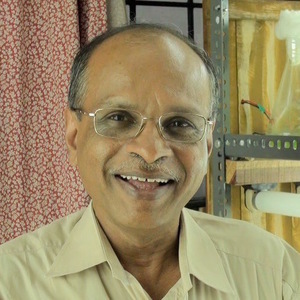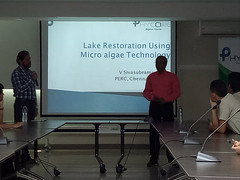V. Sivasubramanian

- Location
-
Chennai
INDIA
- First meeting
- 2010, Oct 22nd
- Last update
- May 2017
- Keywords
- phycoremediation, microalgae, effluent treatment, biofuels
“Nature has all the solutions to the problem we face. It is for us to look for the solutions in nature. One of the solutions is algae. Algae can solve so many problems. And it is for us to look for these algae.“
How to transform a costly industrial effluents treatment process in a new source of income and employment? Using algae!
Dr. V. Sivasubramanian is Associate Professor and the Director of the Phycospectrum Environmental Research Centre (PERC) in Chennai, India. He leads research on phycoremediation. Phycoremediation is the use of macroalgae and microalgae for the removal or biotransformation of pollutants, including nutrients and xenobiotics from wastewater and CO2 from waste air. Based on his research, the first large-scale Indian phycoremediation “no waste” plant was established in 2006 in Ranipet in an alginate industry.
Check information from 2016 to discover how Dr. Sivasubramanian along with his team and collaborators around the world, expands the scope of this algae power and implement pilot plant in various industries.
Background
I did my PhD in marine diatoms1, so actually I cultured about 250 diatoms from Indian Ocean and others places. I selected a few diatoms for further studies on ecophysiology. During my M.Phil also, I did work on fat accumulation in a pennate diatom. I identified various methods by which you can induce more fat accumulation in diatoms. That has become a very important paper now, when people talk about oil from algae. Diatoms are one of the organisms that have been targeted for biofuels resources.
Activities
- Effluent treatment using algae
Now I’m working on effluent treatment using microalgae, especially green algae and blue-green algaes. That is applied to various industries. One of the first industries we have employed algal technology is alginate industry that has been working for the last 5 years, successfully.
After that, we have implemented in confectionery industry, leather processing chemical industries, textile dying industries, electroplating industries and other food industries, where the main idea is to correct the pH, remove sludge, reduce BOD2, COD3 and also degrade or convert or accumulate heavy metals and also degrade other organic acids and other chemicals. This we have achieved in so many industries. Now it is very popular in India, more and more industries are coming and looking forward to adapt this technology and we are also going to do algal farming.
- Algal biomass & biorefinery
Algal farming activities are becoming more popular in these days. And more and more investors, and industries would like to grow algae for biomass and the biomass has an application like biodiesel, biofuels, others biofuels, like bioethanol and all of that and also biofertilizers. And use biomass as nutraceutical and pharmaceutical resources and also animal feed, cattle feed and aquaculture feed. These are all applications, what we call it as biorefinery approach.
The companies, like cement factories and other industries, are coming forward to grow algae. We are starting a farm in a cement industry in Rajasthan, where they want to grow algae in abandoned mines where naturally looking ponds are available: we are going to propel the paddle wheels using windmill generated energy. We’ll grow algae in huge volumes and then harvest the algae and use it as a fuel directly in the furnaces, in the kilns. It is going to be co-fired with coal. We have calculated: if we can replace 5% of coal with algal biomass, they will be saving around 10 crores of rupees (USD: 1,627,075.) in Indian rupees per year. That’s a huge savings, apart from the carbon credits and other benefits they will derive out of this. This is becoming more popular now.
Now we are talking about integrating phycoremediation with algal biomass production, because algal biomass production, if we produce for nutraceutical and pharmaceutical and cosmetic applications, it can be costly. Per kg, it can be even sold at 6000 Rs. But if you want to grow it for biofuels, or other purposes, cattle feed, or chicken feed or agricultural feed, it should be cheaper, so that it can compete with existing market. To make it cheaper, the major inputs are 30% of investments go to nutrient inputs. That can be avoided by using industrial wastes, industry sludge, sewage and other wastewaters that are naturally rich and nutrients are available. These algae can very well grow in these hostile conditions because they are very simple organisms, they adapt very well to any kind of hostile situation. The only thing is that you have to screen and identify which organisms are suitable for your own climatic conditions, in your own area and the kind of water you are going to use, that is the only thing, which is the big headache of the scientist to isolate and look for algae.
India is blessed with huge volume of algae, because of the tropical climatic conditions, hotter climate and high light intensities available through the year, that is very good for growing algae and we are blessed with algae and with the parameters which are needed for algal growth. It is for us to use the algae to our advantages.
About phycoremediation
Sewage treatment using algae is one of the important aspects of applications of algae. In fact Oswald and others started applying algal treatment system for treating domestic sewage. Domestic sewage can be a very comfortable medium for algae to grow. It has all the nutrients and compared to industrial effluents, this is a very simple, very easy. You can easily grow algae in domestic sewage. In fact, the domestic sewage has the high BOD, high COD and odor, and color, all these things can be removed. Even a household can have a treatment system. Apart from their regular treatment system, they can have a secondary reactor sewage treatment using algae so that the water that is treated is completely strip out of nutrients and color is removed. The water becomes so transparent, you can even think of recycling the water, reusing the water by putting it to R/O plant (Reverse Osmosis plant). If not, you can even use it for growing fishes, and if not you can even use it for gardening another purpose, letting it out in the natural water.
In the future, when there is a water crisis, we have to use the wastewater effectively. Algae can be the only solution, because algae are photosynthetic, they are not pathogenic, they are not harmful, so they evolve oxygen, oxygen in the atmosphere, so oxygenation is a major advantage. In future I look to algae as saviors. For various problems. Global warming, pollutions, energy crisis, and food crisis.
Algae for oil slicks?
Another very important application people can think of - I think nobody has worked out also - is how algae can help in oil slick events. Our experience with oil is really positive. We are doing effluent treatment with algae with one industry in Andhra Pradesh in India: they have a treatment plant for treating wastes from oil drilling process, lot of sludge and water. The sludge has still oil sticking on to it.
We have used some species of algae, which has, which are able to remove, reduce the oil, to a percentage less than 2% by treating it. We have designed the treatment process, by which we have treated, and the all sludge becomes a cultivable kind of soil. The advantage is that the texture improves, the organic content improves, the water holding capacity improves, the oil is gone, now we are growing plants in this treated sludge and that is one of the advantages. In fact, the same species of algae can be tried to deal with oil slick, whenever it is not possible, without making physical pollution.
Industrial collaborations
I have been talking about the industrial collaborations that we have done, so far, for the last 10 years, and if you go through our website, our papers, reports, it may look very simple, that you can easily walk into industry and convince them. That’s not easy. It’s very very difficult to convince industries. In fact, as long as you are in the laboratory, you have control on all the parameters. Once you go out of the laboratory, talk about large scale, you don’t have control on almost 99% of the parameters. You are interacting with engineers, and other industry people, investors, commercial fellows to convince them. Unless the industries are convinced about economic viability of the project, they will not support. Unless you have a support from the industry, you can not implement whatever beautiful ideas you have.
You need investors, you need industries, but you have to convince some. That is the major task. For convincing the industries, you should have a background, and a solid research experience on also the data, addressed towards tackling problems of the industry. But unfortunately in India, and also in many places in other parts of the world, the academic research and academic institutions have no connection to industries. Similarly, industries have nothing to do with academic institutions. Academic institutions think that industries are doing something that is not relevant to them, and industries feel that academic institutions talk about something, read something, and learn something that is not directly relevant to their problems. But if you visit industries, you’ll realize that academics, academic research, academicians can do lots of things to solve problems in industries.
One of the problems is pollution, and the academic institutions and researchers can also help in the product development and product process. So you have to reorient your syllabus, (according syllabus) and have a focus on industrial problems. Then you can develop students and trained people who owe a direct, they can be very easily accommodated by industry, for tackling their problems. When we visited industries earlier, we had to have several business earlier, trying to convince some. In fact we had to spend more than 3 or 4 hours by putting up, power points and then discussion and answering their questions. The main thing is to have answers for all questions they ask. You can not say I don’t know, you cannot say it may be possible, you can not say that “maybe after doing that we may understand much better”, but you should have convincing answers. If you want really go for applying this technology, whatever you have to develop, you have to convince the investors, you have to convince the industries, that’s the major problem in fact.
Somewhat, we have been struggling for the last 10 years, for bridging the gap between the academics and the industries. We have been partly successful as you can see from the results we achieved recently.
About sustainability
The major problems that we face today, range from global warming, environmental pollution, energy crisis, and food crisis. All these can be addressed using algae. I’m not telling this because I’m an algologist, there are other reasons.
In fact, if we go back in the history of the Earth, long back, millions of years ago, when the first photosynthetic organisms evolved, it was a blue-green algae, there was no oxygen in the atmosphere, the atmosphere was full of carbon dioxide and there was no ozone layer. It was much more warmer than now so when the first photosynthetic alga evolved, the globe was much warmer, no ozone layer, so it has to face all these hostile conditions. It started doing the photosynthesis, fixing the carbon dioxide, storing them in their biomass and also evolve oxygen. The oxygen that evolved got converted into the ozone layer. The first ozone layer came because of the algae photosynthesis.
That paved the way for other organisms to emerge and in fact we owe our existence to algae. So when algae started doing photosynthesis, they fixed the excess carbon dioxide and fixed them in their biomass, and during the course of evolution and fossilization, it got converted into fossil fuel or crude oil and more than 99% of oil that we take has come from algae.
It is now natural and logical to go back to algae, to “save the world again” because algae has already saved us from global warming, and also energy crisis. Now it is logical to go back to algae, not only for food but also for fuel. And also to reduce global warming by fixing excess carbon dioxide, so by promoting algal growth, both in wastewater treatment and also algal farming for biomass production, we are not only producing valuable biomass, we also remove excess carbon dioxide, that is creating problems on the Earth now.
Now more and more people are aware of this, and in fact if you calculate the amount of oxygen that is evolved by algae, right now, more than 50% of oxygen we breathe come from algae. The ocean, the major 70% of the Earth is surrounded by ocean. Ocean has rich amount of microalgae, diatoms and dianoflagellates and they are the major sink for carbon dioxide. It is for us to utilize those algae, there are about 30000 to 40000 species available. Commercially, we’ll probably utilize only a few algae, for food and other purposes, but we should look for other algal species, screen them and then try to utilize them to our favor, to clean the environment, to increase the energy security and also the food security and prevent further global warming.
Message for the Youth
Anne-Gaëlle: What would you say to an 8 year old child who is affected by the prospect of a future with climate change, pollutions, biodiversity loss, energy crisis and overpopulation?
Nature has all the solutions to the problem we face. We have to look for the solutions in nature. So one of the solutions is algae. Algae can solve so many problems. We have to look for these algae.
As kids, as students, you should concentrate more on these algae, try to grow them in small tanks or small bottles, study their life cycle, how they grow, how they divide, how they reproduce, understand their biology, so that when you want to utilize them later, this knowledge you develop that it’s going to be useful.
Unless you have a basic knowledge of the morphology, taxonomy and identification, life cycle and probably basic on chemistry, ecophysiology and ecology, it is very difficult to utilize them in the biotechnological field. That part is missing. In fact, people want to jump to biotechnology immediately without having any basic fundamental knowledge on the biological systems. Biological systems are so complex, so we can not jump very easily to one place to another.
We have to go very slow, learning many things, because intricacies of nature, even if you spend the entire lifetime, you can not even understand a small bit of it. That is nature, nature has got all the mysteries and intricacies. As kids, you have to start from the school, loving nature, loving algae and trying to identify, observe algae, how they behave, how they move, how the divide, how they reproduce, all these observations can be small identification and the knowledge you develop that will develop you as an algae pioneer and also as an algal biotechnologist later, to use algae for the human welfare.
Update 2016-2017
We got the chance to meet again Dr Sivasubramaian in Chennai on December 14th 2016. Here are some recent news and updates about his work:
- Updates about Phycospectrum:
- Latest developments in phycoremediation:
- International collaborations:
- Innovations and prospects in algae industry:
- Collaboration in Iran: Microalgae cultivation for beta-carotene production. Article
- Petrochemical waste remediation : Collaboration with PHYCORE in Colombia. Article
A JV between Phycospectrum, India and Core Biotech, Colombia, has been officialized and registered in May 2017 in Colombia. The activities will start soom with a project at Sucre, Colombia. Dr Jaime Gutierrez and Dr V Sivasubramanian will coordinate the projects in Latin America.
See also
- Interview of Mr. Rajasekaran, Factory manager of SNAP Natural & Alginate Products where a phycoremediation plant has been implemented.
For more information
Footnotes
-
Diatoms are unicellular microalgae which have a very unique feature: they are enclosed within a cell wall made of silica, called frustule. These frustules show a diversity in form and ornamentations that can be observed only with a microscope. They are very important part of the phytoplankton playing crucial roles for oxygen production and establishment of aquatic food chains. Dive into a water drop and discover this fascinating world through Christian Sardet’s images and the Plankton Chronicles: Life in glass houses ↩
-
BOD: Biochemical oxygen demand is the amount of dissolved oxygen that is required by the bacteria to degrade the organic components present in water/wastewater. ↩
-
COD: Chemical oxygen demand is the total measurement of all chemicals (organics & inorganics) in the water/waste water. ↩


